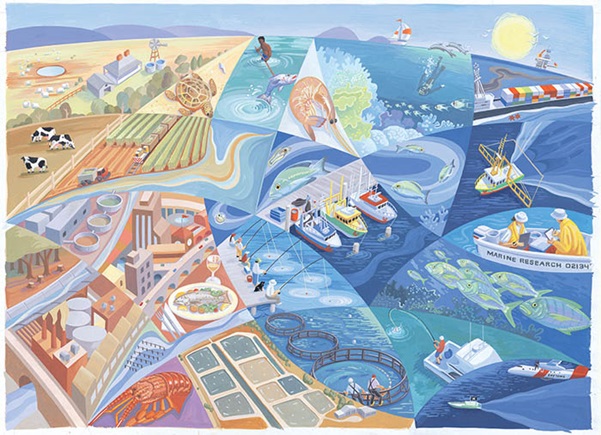The FRDC will take a 10-year view of fishing and aquaculture to 2030 to help guide the development of its next five-year RD&E plan
By Annabel Boyer

Planning for the FRDC’s next five-year research, development and extension (RD&E) plan is underway, with consultation and drafting to be undertaken during the next 12 months.
This plan will guide the direction and provide performance targets for the FRDC investment over that period.
The 2020–25 RD&E Plan will be the seventh plan since the FRDC’s inception in 1992. Each plan takes a contemporary look at the operating landscape and outlines targets against that landscape, areas of high strategic focus (need) and a series of desired outcomes, with the view of further developing fishing and aquaculture in Australia.
Matt Barwick is coordinating and drafting the next RD&E plan. It will incorporate the needs and aspirations of the diverse sectors and industries that make up Australia’s fishing and aquaculture community and will be shaped by the priorities of the Australian Government, the Australian Fisheries Management Forum and FRDC’s five representative organisations.
“It is very clear that you can’t chart a path to the future without knowing where you are,” Matt Barwick says.
“We are starting with an evidence-based situational analysis that looks across all of the sectors of fishing and aquaculture in Australia to help us understand where we are today.”
This kind of analysis has been a fundamental part of the FRDC’s development of its RD&E plan in the past, but Matt Barwick says that this time there will be some significant additions to the process.
“We are also adding a forecasting project, which looks over a 10-year time horizon to ask the question, ‘what are the big changes coming our way and what are the drivers for those changes, both for fishing and aquaculture and the country more broadly?’ ” Matt Barwick says.
The 2020–25 RD&E Plan will be informed by a three to four month period of consultation. The FRDC is looking to include a diverse range of participants in each stage of the consultative process, drawing from the breadth of the fishing and aquaculture industry, Matt Barwick says.
“That breadth and diversity is one of our bigger challenges, but also an opportunity in a process like this. We have people [who] derive income and livelihood catching fish; people for whom a great day of fishing means they come home without anything at all, having released everything; and, very importantly, Indigenous communities, which value fishing differently again.”
The process will be designed to provoke thought and feedback on possible future states of fishing and aquaculture in Australia; to organise activities to respond to key internal and external driving forces; and to propose improvements to systems, investment frameworks and processes to improve efficiency in delivery of outcomes through investment in RD&E.
Matt Barwick says the FRDC will take a “mixed-methods” approach to ensure that different voices are heard. This will include face-to-face workshops and forum-style events, as well as online input that will solicit feedback on an insights paper expected to come from the “forecasting” project.
“One thing is clear from the early discussion we’ve had so far is that the world, not just fishing and aquaculture, is operating in a more uncertain environment. As those conditions amplify, so does the need for change. This means we need to plan for this change now.”
The FRDC 2020–25 RD&E Plan will be informed by:
- a contemporary snapshot of fishing and aquaculture today, updating earlier work conducted in 2014 (FRDC Project 2014-503.20);
- a horizon-scanning process looking over a 10-year time horizon (2030) that considers geopolitical, social, economic, environmental and technical changes likely to occur over 2020–30; drivers of those changes; and implications for fisheries production/targeting, trade, pricing, fishing participation, expenditure, and the environment;
- the independent review of the FRDC’s performance, and proposed independent review of Research Advisory Committees (RACs) and Industry Partnership Agreements (IPAs); and
- strategic plans for the FRDC’s IPAs and RACs, which operate in parallel to the RD&E plan.
To have your say email the FRDC.
Click here for more information on the FRDC’s development of its 2020–25 RD&E Plan and a full consultation plan.
FRDC RESEARCH CODE: 2018-197
More information
Matt Barwick
FRDCplan@frdc.com.au





